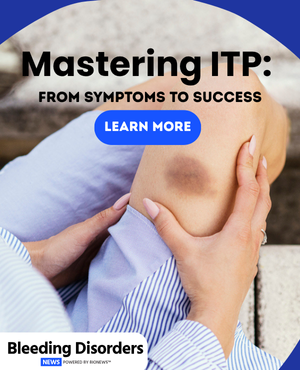
Corticosteroids for immune thrombocytopenia
Last updated July 14, 2025, by Lindsey Shapiro, PhD

What are corticosteroids?
Corticosteroids, sometimes called steroids, are powerful immune-suppressing medications that are often the first-line treatment for immune thrombocytopenia (ITP).
In ITP, the immune system mistakenly attacks and destroys healthy platelets, the cell fragments that help blood clot and stop bleeding after an injury. This leaves patients more prone to easy or excessive bleeding.
Corticosteroids are lab-made medications that mimic cortisol, a naturally occurring hormone produced by the adrenal glands, which sit atop the kidneys. Cortisol plays a key role in regulating inflammation and immune responses.
By imitating cortisol, corticosteroids help reduce the immune system’s attack on platelets, thereby increasing platelet levels and lowering the risk of bleeding.
The specific corticosteroids used for ITP work by binding to glucocorticoid receptors. For this reason, they are also commonly referred to as glucocorticoids.
When are corticosteroids used for immune thrombocytopenia?
Corticosteroids are the standard first-line treatment for people with ITP. They are typically started when platelet counts fall below a certain threshold, putting a person at risk of significant bleeding. But other factors, such as a person’s age, overall health, and the severity of symptoms, are also factored in when deciding to begin treatment.
There are various types of corticosteroids, but the main ones used for ITP include:
- prednisone (or its active form, prednisolone)
- dexamethasone
- methylprednisolone.
Treatment guidelines generally recommend people with ITP receive short courses of oral corticosteroids to help raise platelet levels. These medications are then tapered off over a period of days to weeks.
Prednisone and dexamethasone are the most commonly used oral options. The specific treatment plan depends on platelet responses, side effects, and individual clinical factors.
Because oral corticosteroids can take some time to start working, some patients may receive them via infusions into the bloodstream (intravenously) to kickstart a faster response. This may be needed in urgent cases, for instance, when platelet counts are dangerously low or if the person is experiencing severe or critical bleeding. Methylprednisolone or dexamethasone are often used for this purpose.
In general, current guidelines recommend steroids be used for a short duration of six weeks or less in adults, and seven days or less in children. Longer use is not believed to offer additional benefits and may increase the risk of serious side effects.
While first-line steroids can push ITP into remission, where platelet counts are stable and the risk of bleeding is low, relapses are common after tapering, and less than 30% of patients are thought to achieve sustained remission after receiving steroids alone.
A poor response to corticosteroids or repeated relapses may prompt the need for second-line treatments, which work to raise platelet levels through other mechanisms.
Corticosteroid side effects
While there are numerous benefits of corticosteroids for ITP, most people on these treatments experience side effects, some of which can be serious. Corticosteroids side effects are particularly likely when the medications are used at high doses and for extended periods of time.
Specific side effects can vary depending on the corticosteroid type and dosage, but some common side effects include:
- infections
- weight gain
- skin changes
- growth delays in children
- high blood pressure
- sleep and mood disturbances
- muscle weakness and bone thinning.
Because corticosteroids mimic the natural hormone cortisol, the body responds by decreasing its own cortisol production. If corticosteroids are stopped suddenly, before the body resumes its usual cortisol production, withdrawal symptoms may occur and could include:
- severe fatigue
- weakness
- body aches
- joint pain
- nausea and appetite loss
- irritability or mood swings.
In rare cases, a sudden drop in cortisol levels can lead to a serious complication called adrenal crisis, which can be life-threatening.
To avoid withdrawal symptoms, corticosteroids are gradually tapered off rather than stopped abruptly. People with ITP should never stop using corticosteroids without first consulting their healthcare provider about how to do so safely.
Bleeding Disorders News is strictly a news and information website about the disease. It does not provide medical advice, diagnosis, or treatment. This content is not intended to be a substitute for professional medical advice, diagnosis, or treatment. Always seek the advice of your physician or other qualified health provider with any questions you may have regarding a medical condition. Never disregard professional medical advice or delay in seeking it because of something you have read on this website.
Recent Posts
- ITP treatment Doptelet may help prevent bone loss in osteoporosis
- Bleeding risk high soon after kidney transplant in VWD, hemophilia A
- Combined therapy aids recovery for woman with TTP and lupus
- An ITP diagnosis wasn’t the final word on my health setbacks
- Cell therapy QT-019B shows strong response rate in hard-to-treat ITP
Related articles
-

-
-

THROMBOTIC THROMBOCYTOPENIC PURPURA
NewsCombined therapy aids recovery for woman with TTP and lupus
-
-
-




